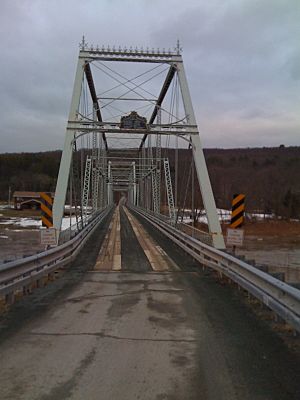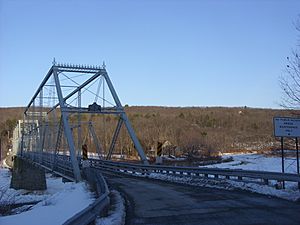Skinners Falls–Milanville Bridge facts for kids
Quick facts for kids Skinners Falls – Milanville Bridge |
|
|---|---|
 |
|
| Coordinates | 41°40′11″N 75°03′30″W / 41.669626°N 75.058358°W |
| Carries | One lane of Skinners Falls Road |
| Crosses | Delaware River |
| Locale | Milanville, Pennsylvania and Skinners Falls, New York |
| Official name | Skinners Falls – Milanville Bridge |
| Owner | New York–Pennsylvania Joint Interstate Bridge Commission |
| Maintained by | New York–Pennsylvania Joint Interstate Bridge Commission |
| Characteristics | |
| Design | Baltimore Through Truss |
| Total length | 470 feet (140 m) |
| Number of spans | Two |
| History | |
| Designer | American Bridge Company |
| Construction begin | 1901 |
| Construction end | November 1902 |
| Opened | 1902 |
| Closed | 2010–2013, 2015–2016, 2018 |
| Statistics | |
| Toll | $0.22 (until the 1920s) |
The Skinners Falls – Milanville Bridge is a bridge that crosses the Delaware River. It connects Milanville, Pennsylvania, and Skinners Falls, New York. These places are in Wayne County, Pennsylvania and Sullivan County, New York.
The bridge is 470 feet (140 m) long. It has only one lane for Skinners Falls Road, which is a local street. The American Bridge Company built this bridge. The Milanville Bridge Company paid for its construction. This bridge took the place of a ferry service run by Daniel Skinner and his family. The bridge opened in 1902 and has been used for many years. It is one of several bridges in Sullivan County that are listed on the National Register of Historic Places. Other famous bridges include the Roebling Aqueduct and the Pond Eddy Bridge.
Contents
Building the Bridge (1764–1902)
In 1764, the area between Skinners Falls and Milanville was important for moving timber. The Skinner family, who were well-known in the area, used this spot for timber rafting. That year, Daniel Skinner was the first to float a timber raft down the Delaware River. Because of this amazing feat, he was given the title "Lord High Admiral." This honor is still remembered today.
The Skinners lived in a place called Milanville. However, many locals knew it as Skinners Falls. Further up the Delaware River, another Skinner family member, Milton L. Skinner, ran a private ferry. This ferry carried people across the river between Pennsylvania and New York. Milton and his brother, Volney, also ran a sawmill in Pennsylvania. For many years, these two rivermen were very important in the area.
The idea to build a bridge here didn't come up until the 1900s. In 1900 and 1901, local leaders thought it was time for a bridge. A company started by Milton L. Skinner opened in 1901. Its goal was to sell shares, build the bridge, and then operate it for everyone to use. This company was called the Milanville Bridge Company. It was located in Milanville, on the Pennsylvania side. At first, people called it the Milanville Bridge. But over time, locals started calling it the "Skinners Falls Bridge."
The company received permission from Pennsylvania to build the bridge in late 1901. They hired the American Bridge Company to do the construction. Building didn't get very far before a big ice flood hit. The river rose so high it reached the second floor of homes in Milanville. This flood, along with some local disagreements, caused a short delay in building.
Other bridge owners also complained about the new bridge. The companies that owned the nearby Narrowsburg–Darbytown Bridge and Cochecton–Damascus Bridge were worried about competition. They said the new bridge was not needed, especially since it was only 3 miles (4.8 km) from their bridges. These issues even reached Albany, the capital of New York.
John Anderson, the lawyer for the Cochecton Bridge, went to Albany to argue against the new bridge. The main concern was that the new bridge could only handle one lane of traffic. This meant the other two bridges would still be needed for people in a hurry. Eventually, the companies reached a compromise. The American Bridge Company finished building the bridge in November 1902. The total cost was $14,000.
Private Bridge Operation (1902–1920s)
After the Skinners Falls–Milanville Bridge was finished in late 1902, people had to pay a toll to cross it. This one-lane bridge cost $0.22 (in 1902 money) to use. However, people walking across the bridge did not have to pay. This was different from other bridges. Another special rule was that ministers did not have to pay tolls. This was so they could better serve their communities. But one minister started using this special privilege too much. After that, he was charged $0.05 to cross. The tollhouse was in Milanville, and the Dexter family managed it.
Just two years after it opened, a flood in March 1904 badly damaged the bridge. The owners hired the Horseheads Bridge Company, run by the Perkins brothers. They charged $7,000 (in 1904 money) to fix the bridge. After the bridge reopened, and with a new Erie Railroad station, Skinners Falls and Milanville saw new growth. An acid company, a creamery, and a dairy company opened. These businesses helped the bridge earn money from the $0.22 toll.
However, the Skinners' timber rafting business did not survive. It had been operating for over 140 years. In 1914, J. Skinner owned the company. But it faced a disaster when one of their timber rafts crashed into a ferryboat owned by the Myers family. Four people died in the accident. The ferry operator was blamed. Also, there were fewer trees along the river, making timber rafting difficult. In 1914, the Skinner timber rafting business closed down.
Bridge Commission Takes Over (1920s–Present)
In the 1920s, the New York – Pennsylvania Joint Bridge Commission was created. This group was a early version of the current Delaware River Joint Toll Bridge Commission. Its goal was to buy bridges from private owners. This meant that tolls on bridges along the Delaware River would soon end. The Commission offered the Milanville Bridge Company $19,542.22 (in 1920s money). The company accepted the offer.
Under new ownership, the tolls were removed. More people used the bridge after the tolls were gone, and local businesses continued to do well. The new owners made sure the bridge was regularly maintained. Because of this, the bridge has stayed strong. Even during the big floods from Hurricanes Connie and Diane in 1955 and other floods in the 1960s, the bridge had little to no damage.
From May to October 1986, the commission closed the bridge for repairs. They replaced the wooden deck, painted the entire bridge, and added new guide rails. The bridge still had a weight limit of 3 tons (6000 lb) after these updates. On November 14, 1988, the bridge was added to the National Register of Historic Places.
Times the Bridge Closed
On January 19, 2010, the Pennsylvania Department of Transportation closed the Skinners Falls – Milanville Bridge. They found a problem with one of the bridge's main support parts, called a truss member. The bridge was supposed to get repairs later that year for $200,000 (in 2010 money). A bigger repair project, costing $8 million (in 2015 money), was planned for 2015. By July 2013, the bridge was open again for cars.
However, an inspection on December 11, 2015, showed new problems. The bridge's suspension wires were twisted and out of line. This made the bridge unsafe for vehicles. The Pennsylvania Department of Transportation announced that the 114-year-old bridge would be closed for a long time. A DOT spokesperson, James May, said, "This is not something that's going just weeks or even months; it's going to be a while."
Throughout 2016, the necessary repairs were made. By November 2016, the bridge was open to traffic again. Height bars were put at both ends of the bridge. These bars stop heavy vehicles from using the bridge. Heavy vehicles had caused the most recent damage to the structure.
The bridge closed again in early 2018. More damage was found, and the middle support pier was hurt by ice in the Delaware River. By November 2018, the bridge was open again for traffic. It still allowed only one vehicle to cross at a time, in one direction. As of summer 2020, the bridge is currently closed.


